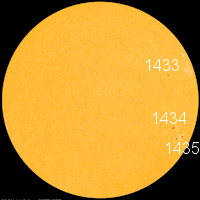ELECTRON STORM: The number of energetic electrons in Earth's outer radiation belt is significantly elevated. According to analysts at the Goddard Space Weather Lab, the enhancement is caused by the aftermath of recent geomagnetic storms mixed with a high-speed solar wind stream. "Spacecraft at GEO, MEO and other orbits passing through or in the vicinity of the Earth's outer radiation belt can be impacted," they say.
FIRST DAY OF NORTHERN SPRING: The seasons are changing. Today, March 20th, the sun crossed the celestial equator heading north. This marks the beginning of Spring in the northern hemisphere and Autumn in the southern hemisphere. At this time of year, day and night are of nearly equal length, hence the name "equinox" (equal night).
Good news for sky watchers: Spring is aurora season. For reasons not fully understood by researchers, the weeks around equinoxes are prone to Northern Lights. "With the exception of one cloudy night we have now seen the auroras 16 nights in a row," reports aurora tour guide Chad Blakley from the Abisko National Park in Sweden. "What a season!" He snapped this picture on March 19th:
"I combined some of the photos to make a time-lapse movie," says Blakley. "It was another great night in Abisko!"
NOAA forecasters estimate a 20% chance of polar geomagnetic storms tonight. The odds of auroras, however, might be even better. Happy Equinox! Aurora alerts: text, phone.
more images: from Nenne Åman of Arjeplog, Sweden; from Dirk Obudzinski of Steese National Conservation Area, Alaska; from B.Art Braafhart of Salla, Finnish Lapland; from Larry Jenkins of Labrador City, NL Canada; from Jónína Óskarsdóttir of Faskrudsfjordur, Iceland; from Peter Scott of Durness, Scotland, UK; from Francis Anderson of Tuktoyaktuk, Northwest Territories Canada;

![]()
Solar wind
speed: 434.1 km/sec
density: 0.8 protons/cm3
explanation | more data
Updated: Today at 1635 UT
![]()
X-ray Solar Flares
6-hr max: B4 1454 UT Mar20
24-hr: B4 1454 UT Mar20
explanation | more data
Updated: Today at: 1600 UT
![]()
![]()
![]()
Daily Sun: 20 Mar 12
![]()
![]()
All of these sunspots are quiet. No strong flares are in the offing. Credit: SDO/HMI
![]()
![]()
![]()
Sunspot number: 58
What is the sunspot number?
Updated 19 Mar 2012
Spotless Days
Current Stretch: 0 days
2012 total: 0 days (0%)
2011 total: 2 days (<1%)
2010 total: 51 days (14%)
2009 total: 260 days (71%)
Since 2004: 821 days
Typical Solar Min: 486 days
Updated 19 Mar 2012
The Radio Sun
10.7 cm flux: 102 sfu
explanation | more data
Updated 19 Mar 2012
![]()
![]()
![]()
Current Auroral Oval:
![]()
Switch to: Europe, USA, New Zealand, Antarctica
Credit: NOAA/POES
![]()
![]()
![]()
Planetary K-index
Now: Kp= 1 quiet
24-hr max: Kp= 2 quiet
explanation | more data
![]()
Interplanetary Mag. Field
Btotal: 1.8 nT
Bz: 1.5 nT south
explanation | more data
Updated: Today at 1637 UT
![]()
![]()
![]()
Coronal Holes: 20 Mar 12
![]()
![]()
There are no large coronal holes on the Earthside of the sun. Credit: SDO/AIA.





